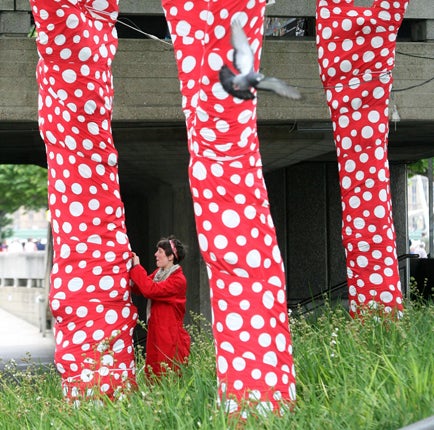Walking in My Mind, Hayward Gallery, London
The Freudian mind is a busy place. Better to keep it simple

Of the many triumphs of Sigmund Freud, perhaps the greatest is his Gaul-like division of the mind into three parts, id, ego and super-ego.
Freud's model is so catchy because it is so simple – a trio of interconnected chambers, their interrelations shown as if by arrows. And if it's easy to picture the Freudian psyche graphically, it's even easier to do so sculpturally. Imagine an exhibition titled Walking in My Mind and you might come up with a series of stroll-through installations, their bits and bobs drawn from The Psychopathology of Everyday Life. In this regard at least, a new show at the Hayward Gallery does not disappoint.
The blurb says Walking in My Mind is "an expedition into the mysterious mental processes of creativity" (unlike, say, the Sistine Chapel ceiling). Instead of merely being creative, the 10 artists in the show are creative about their own creating, a circularity that may call to mind the sin of Onan. Each has made a walk-through mindscape, a psychic self-portrait in the form of an installation. That, at least, is how the curators want us to see the works.
I'm not a big fan of maximal art, the kind that conjures up complexity by being very complex. Take Jason Rhoades's The Creation Myth. Visitors will tumble over each other to see this, largely because of a sign that warns of lewd content. (Prepare to be disappointed.) The Freudian mind is a busy place, and The Creation Myth is commensurately busy, with tables, chairs, TVs, plastic buckets labelled The Prick, The Grey Matter, etc, machinery, cardboard turds, laser prints of porn magazines, a toy train trundling around with a draught-excluding snake on its back, and other mixed media. Sawn-off bits of cylindrical lumber imply castration complexes and there's a notice about Darwin to suggest that Rhoades, who died young, had read a lot. And?
Charles Avery's complexity is of a different sort, although it, too, is the point of his work. Avery's oeuvre consists of cod-anthropological specimens from a mythical island. Some are presented as objects in vitrines – a spiky hat, flints – and some as gouaches on the wall. Avery takes the walking bit of the show's title literally. One part of his installation is downstairs, another upstairs, a third out on a terrace – you have to pass through Bo Christian Larsson's ho-hum homage to Beuys to get from one to the other. The feeling, though, is not of mystery but of contrivance, of cleverness rather than imagination.
And that is my problem here. Those early apostles of St Sigmund, the Surrealists, faced the same conundrum: if the psyche is irrational, how do you rationalise it? Their best answers were found not in complexity – Dali's swans and clocks, say – but in simplicity: Meret Oppenheim's fur teacup, whose juxtaposing of two known things makes you shudder with unknowing.
In this show it is not the ponderously thought-through work of Keith Tyson and Thomas Hirschhorn that stays with you, but the uncanny simplicity of three artists, all Japanese. In Yoshimoto Nara's case the simplicity is less Freudian than Jungian, Nara's installation being that archetypal thing, the hut. To look through the windows of his comic-filled Wendy house, My Drawing Room, is to feel a common mourning of childhood. Yayoi Kusama, now 80, has lived for years as a voluntary in-patient at a Tokyo mental hospital. Her famously polka-dotted soft sculptures are drawn from hallucinations but carry universal echoes of myth and scale. Kusama's room in this show, filled with spotty inflatables, co-opts you as a character in a fairy tale, or perhaps as a fifth Teletubby.
It is the least known of the three artists who really impresses. Chiharu Shiota has filled a section of the Hayward's top floor with a tunnel of stretched black threads, imprisoning, in one part, white spectral shapes. What this evokes – Jungian woodland, a vagina – I cannot say, but evoke it does. And its relation to Shiota's creative mind? You tell me.
Join our commenting forum
Join thought-provoking conversations, follow other Independent readers and see their replies
Comments
Bookmark popover
Removed from bookmarks